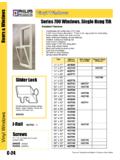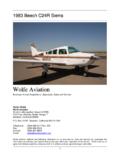Transcription of SD-03-3510 Bendix RV-1 Pressure Reducing Valve
1 1SD-03-3510 DESCRIPTIONThe RV-1 Pressure Reducing Valve is used to reduce airpressure and maintain it at a constant specified pre-setpressure below that of the supply Pressure . The pressurereducing Valve has a 1/4" delivery port on the side and a 1/4"supply port on the bottom. Two 9/32" mounting holes arecast into the body. A lockwire and seal are optional for atamper proof Pressure setting of the Pressure Reducing Valve isdetermined by the setting of the adjusting cap, which exertsa force on the spring on top of the piston. Compressed airenters the supply port and passes out the delivery the air Pressure on the bottom of the piston overcomesthe force of the spring on top of the piston, the piston movesupward and the inlet Valve spring forces the inlet Valve on itsseat, closing off the supply of air.
2 As the Pressure in thedelivery line drops, the force of the spring above the pistonbecomes greater than the air Pressure below the piston,allowing the piston to move downward, moving the inlet valveoff its seat and allowing air to pass out the delivery Pressure in the delivery line exceeds the Pressure settingof the Pressure Reducing Valve , the force exerted by the airpressure below the piston will be greater than the springforce above the piston. The piston will move up from theexhaust Valve , permitting air to pass by the exhaust Valve ,through the hollow piston and Valve guide and escape throughthe slot in the adjusting cap.
3 When the force of the springabove the piston overcomes that of the air Pressure belowthe piston, the exhaust Valve is seated, and the Pressure inthe delivery line is the same as the setting of the pressurereducing : The RV-1 Valve should be used in light dutyapplications where the supply and delivery Pressure is stableand constant. A rapid or pulsed supply and/or deliverypressure is not recommended. Please consult BendixEngineering with specific application AND LEAKAGE TESTSC onnect a 120 psi Pressure source to the supply port andconnect an accurate test gauge to the delivery.
4 Observe thegauge with the supply Pressure applied, this is the deliverypressure (the inlet Valve is closed). If the Pressure deliveredis more than 5 psi from the Pressure indicated on the tagattached to the Valve or vehicle manual, the Valve can bereadjusted. Momentarily bleed off some of the deliverypressure. Discontinue bleed off and recheck the deliverypressure. The delivery Pressure should again be within 5psi of the Pressure indicated on the for leakage at the adjustment cap base with soapsolution. Leakage should not exceed 100 SCCM or a 1"bubble in 5 or less seconds.
5 Excessive leakage may indicatea leaking piston o-ring or inlet/exhaust RV-1 Pressure Reducing ValveLOCK WIRE& SEALMOUNTINGHOLESADJUSTING CAPSUPPLYPORTEXHAUSTVENTVALVE GUIDEWIREINLET &EXHAUSTVALVEPISTONINLET VALVESPRINGPRESSUREREGULATINGSPRINGPISTO NO-RINGCAPLOCKNUTDELIVERYPORT2 Valve ADJUSTMENTIf the RV-1 Valve does not deliver as described, and leakageis minimal, the Valve can be readjusted as Remove lockwire (if used).2. Loosen the cap lock nut while holding the adjusting Turn the adjusting cap clockwise to increase Pressure ,counter clockwise to reduce The lock nut should be tightened after readjustment, whileholding the adjustment cap Recheck the delivery Pressure as Reattach the lockwire and replace the seal if the RV-1 Valve does not function as described or ifexcessive leakage occurs, it is recommended that it berepaired/replaced with genuine Bendix MAINTENANCEI mportant: Review the Bendix Warranty Policy beforeperforming any intrusive maintenance procedures.
6 A warrantymay be voided if intrusive maintenance is performed duringthe warranty two vehicles operate under identical conditions, as aresult, maintenance intervals may vary. Experience is avaluable guide in determining the best maintenance intervalfor air brake system components. At a minimum, the RV-1 Valve should be inspected every 6 months or 1500 operatinghours, whichever comes first, for proper operation. Shouldthe RV-1 Valve not meet the elements of the operationaltests noted in this document, further investigation and serviceof the Valve may be ! PLEASE READ AND FOLLOWTHESE INSTRUCTIONS TO AVOIDPERSONAL INJURY OR DEATH:When working on or around a vehicle, the followinggeneral precautions should be observed at all Park the vehicle on a level surface, apply theparking brakes, and always block the wear safety Stop the engine and remove ignition key whenworking under or around the vehicle.
7 Whenworking in the engine compartment, the engineshould be shut off and the ignition key should beremoved. Where circumstances require that theengine be in operation, EXTREME CAUTION shouldbe used to prevent personal injury resulting fromcontact with moving, rotating, leaking, heated orelectrically charged Do not attempt to install, remove, disassemble orassemble a component until you have read andthoroughly understand the recommendedprocedures. Use only the proper tools and observeall precautions pertaining to use of those If the work is being performed on the vehicle s airbrake system, or any auxiliary pressurized airsystems, make certain to drain the air Pressure fromall reservoirs before beginning ANY work on thevehicle.
8 If the vehicle is equipped with an AD-IS air dryer system or a dryer reservoir module, besure to drain the purge Following the vehicle manufacturer srecommended procedures, deactivate the electricalsystem in a manner that safely removes allelectrical power from the Never exceed manufacturer s Never connect or disconnect a hose or linecontaining Pressure ; it may whip. Never remove acomponent or plug unless you are certain allsystem Pressure has been Use only genuine Bendix replacement parts,components and kits. Replacement hardware,tubing, hose, fittings, etc.
9 Must be of equivalentsize, type and strength as original equipment andbe designed specifically for such applications Components with stripped threads or damagedparts should be replaced rather than repaired. Donot attempt repairs requiring machining or weldingunless specifically stated and approved by thevehicle and component Prior to returning the vehicle to service, makecertain all components and systems are restoredto their proper operating AND INSTALLATIONREMOVAL1. Block and hold the vehicle by means other than air Drain the service and isolated Disconnect the air lines from the Pressure Reducing Loosen the Valve mounting bolts and remove the Check and clean air lines to Mount the Valve securely with bolts and Reconnect the lines to the DISASSEMBLY1.
10 Loosen lock nut, hold the adjusting cap stationary andremove lockwire if Remove the adjusting cap and lock Remove the Pressure regulating Remove the piston assembly and Using needle-nose pliers grab the end of the inlet valvespring and rotate it to dislodge the inlet and exhaust valvespring from groove of supply port. Remove the spring andinlet/exhaust AND INSPECTIONWash all metal and plastic parts in mineral spirits. Rubberparts should be wiped clean. Inspect all parts for wear ordeterioration. Check springs for cracks, corrosion ordistortion. Inspect all rubber parts and replace if they showsigns of cracks, wear, deterioration, or are swollen.









